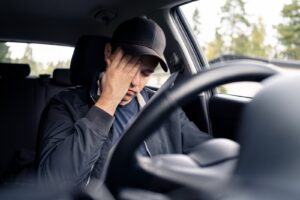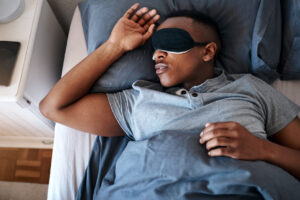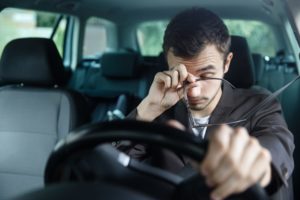Diagnosing Narcolepsy
Narcolepsy is a sleep disorder marked by excessive daytime sleepiness (EDS), which can cause significant health consequences for children, teens, and adults. Both types of narcolepsy, known as narcolepsy type 1 (NT1) and type 2 (NT2), are rare.
As an uncommon disorder, narcolepsy may not be immediately recognized or suspected, which is why many cases are believed to be undiagnosed or only diagnosed many years after the start of symptoms . Unfortunately, delayed diagnosis can prevent patients from getting treatment that can improve their safety and quality of life. Understanding the multi-step process to diagnosis can help individuals with symptoms of narcolepsy work with their doctor and know what to expect during appointments and tests.
Who Diagnoses Narcolepsy?
Narcolepsy must be diagnosed by a health professional. A medical doctor — normally your primary care physician (PCP) — coordinates the diagnostic process.
In some cases, a referral may be made to a doctor who specializes in sleep medicine, a neurologist, and/or a psychiatrist to conduct additional evaluations that may aid in diagnosis and treatment.
How Is Narcolepsy Diagnosed?
Anyone who is concerned about excessive daytime sleepiness (EDS) or narcolepsy should start by talking with their primary care physician or family doctor. This first contact can initiate the diagnostic process, which involves several steps.
At the outset, the doctor needs to find out more about your symptoms, review your health history, and do a basic physical exam. To better understand your symptoms, the doctor may ask questions like:
- How much do you normally sleep at night?
- Do you have difficulty falling asleep at night?
- Do you wake up often during the night?
- Do you feel sleepy and/or take naps during the day?
- Over the last two weeks, how often have you fallen asleep when you didn’t intend to?
- Do you fall asleep without warning during the day?
- Does daytime drowsiness affect your focus at school or work or when driving?
- Do you feel refreshed when waking up in the morning? When waking up from a nap?
- Do you dream during naps?
- Do you sleep more on weekends than weekdays?
- Do you experience temporary paralysis or hallucinations when falling asleep or waking up?
- Have you ever experienced the brief and sudden loss of muscle tone or muscle control (a symptom called cataplexy)?
- Do you snore loudly or make gasping or choking sounds while asleep?
EDS can be caused by many conditions, and your answers to these questions provide valuable information that helps the doctor identify the most likely explanation. A physical exam and a review of your health history and current medications can also help rule out other causes of your symptoms.
To gather more information about your sleep, the doctor may ask you to take a short test called the Epworth Sleep Scale (ESS). Your subjective responses to these survey questions help the doctor quantify your sleepiness.
In addition, you may be asked to keep a sleep log, which is a diary of your sleep habits, for a week or more. Another way to measure your sleep is with actigraphy, which is a watch-like device that uses a tracker to monitor your movement.
While all of this information can be essential, narcolepsy cannot be diagnosed on the basis of symptoms alone. Instead, other tests must be conducted to discount other potential causes of symptoms and confirm a narcolepsy diagnosis.
Polysomnography and the Multiple Sleep Latency Test
If your doctor suspects that you may have narcolepsy or another sleep disorder, it’s common for them to recommend two specialized sleep studies:
- Polysomnography (PSG) tracks your breathing, eye movement, muscle movement, and brain activity, and is usually conducted overnight in a sleep clinic. PSG documents your sleep stages and awakenings, and it can also reveal the presence of other disorders such as sleep apnea.
- The Multiple Sleep Latency Test (MSLT) is normally conducted in the morning immediately following the PSG. During this test, you remain connected to the sensors used in the PSG. At five separate intervals, you are instructed to try to fall asleep, and the MSLT measures how quickly you fall asleep and how quickly you enter rapid eye movement (REM) sleep.
Both PSG and MSLT are complex tests performed in a specialized sleep clinic. At-home testing is not an option for narcolepsy because it lacks the necessary monitoring of brain activity.
The results of the PSG and MSLT can be critical in diagnosing narcolepsy . People with both NT1 and NT2 tend to fall asleep in less than eight minutes on average, and they usually enter REM sleep much earlier than people without narcolepsy.
To ensure these tests produce valid results, it’s vital to prepare for them correctly . Preparation includes stabilizing your sleep schedule for at least a week beforehand, which may need to be documented by a sleep log or actigraphy. It’s also important to stop using medications or substances that could interfere with your sleep during the tests.
Your doctor or a technician at the sleep clinic can provide specific instructions and let you know what to expect before you go in for these sleep studies.
Hypocretin and HLA Testing
A lumbar puncture removes some cerebrospinal fluid (CSF) from the lower spine that can be tested for its levels of hypocretin. Also called orexin, hypocretin is a chemical that helps control sleep and wakefulness. Low levels are indicative of narcolepsy type 1, which involves the loss of neurons in the brain that produce hypocretin.
Along with low hypocretin levels, almost everyone with NT1 carries a variation in a gene called HLA-DQB1*06:02. Human leukocyte antigen (HLA) testing can look for this variation, but, because it exists in many people without narcolepsy, it alone is not capable of providing a diagnosis.
What Are the Criteria for Diagnosing Narcolepsy?
Taking all of the information — your symptoms, physical exam, and results from sleep studies and other tests — into account, the doctor can determine whether your situation meets the established criteria for narcolepsy.
Narcolepsy type 1 and type 2 have distinct criteria. One important differentiating factor between the two disorders is whether or not you have cataplexy, which is a sudden and temporary loss of muscle tone that commonly occurs with positive emotions. Cataplexy only occurs in NT1.
A comparison of the diagnostic criteria is listed in the following table:
| Narcolepsy Type 1 | Narcolepsy Type 2 |
|---|---|
The patient must meet both of the following criteria:
| The patient must meet all five of the following criteria:
|
It is possible for a person’s diagnosis to change over time. Around 10% of people who are initially diagnosed with NT2 will develop cataplexy at a later date, at which point their diagnosis is reclassified as NT1.
What Disorders Can Mimic Narcolepsy?
Although cataplexy is highly specific to NT1, it may be mistakenly identified as a seizure or stroke. Other symptoms like sleep paralysis and hallucinations can occur independently of narcolepsy and as symptoms of other disorders as well.
Unlike NT1, which can be identified with a test for CSF hypocretin levels, there is no definitive test or biomarker for NT2 . Because its symptoms overlap with those of other disorders, like idiopathic hypersomnia and excessive daytime sleepiness, doctors frequently have to use careful judgment to make a differential diagnosis.

Is Narcolepsy Diagnosed the Same Way in Children, Teens, and Adults?
The same diagnostic process and criteria for narcolepsy are used for children, teens, and adults. That said, there may be special considerations when evaluating younger patients:
- EDS in children may manifest as irritability or hyperactivity , which can cause narcolepsy to be misdiagnosed as attention-deficit/hyperactivity disorder (ADHD) or another behavior disorder.
- Cataplexy may begin with more subtle movements in children, including many that only involve the face. These may be overlooked entirely or misidentified as facial tics.
- Involving parents in the diagnostic process is often essential, especially for younger children who may struggle to recount their sleep habits or verbalize symptoms like sleep paralysis or hallucinations.
- The MLST has not been specifically validated for young people, and some adolescents with narcolepsy may have normal results on initial testing.
What Questions Can You Ask Your Doctor About Narcolepsy?
If you’re planning to talk with your doctor about narcolepsy, being ready for your appointment helps. Be prepared to carefully describe your symptoms and how long you’ve had them. You may also benefit from bringing a list of questions. Examples of potential questions include:
- Are my symptoms consistent with narcolepsy?
- What else could be causing my symptoms?
- What tests do you recommend to determine the cause of my symptoms?
- Are there any special instructions to prepare for the tests that you recommend?
- When will the results of those tests be available?
- Are there any steps that I can take to improve my symptoms in the meantime?
- Would it be beneficial to have an appointment with a sleep specialist or another type of medical specialist?
References
10 Sources
-
Barker, E. C., Flygare, J., Paruthi, S., & Sharkey, K. M. (2020). Living with narcolepsy: Current management strategies, future prospects, and overlooked real-life concerns. Nature and Science of Sleep, 12, 453–466
https://pubmed.ncbi.nlm.nih.gov/32765142/ -
Thorpy, M. J., & Krieger, A. C. (2014). Delayed diagnosis of narcolepsy: Characterization and impact. Sleep Medicine, 15(5), 502–507.,
https://pubmed.ncbi.nlm.nih.gov/24780133/ -
American Academy of Sleep Medicine. (2014). International Classification of Sleep Disorders — Third Edition (ICSD-3) (Online).
https://aasm.org/ -
Pizza, F., Filardi, M., Moresco, M., Antelmi, E., Vandi, S., Neccia, G., Mazzoni, A., & Plazzi, G. (2020). Excessive daytime sleepiness in narcolepsy and central nervous system hypersomnias. Sleep & Breathing, 24(2), 605–614.
https://pubmed.ncbi.nlm.nih.gov/31154621/ -
National Institute of Neurological Disorders and Stroke. (2020, September 30). Narcolepsy fact sheet.
https://www.ninds.nih.gov/Disorders/Patient-Caregiver-Education/fact-sheets/narcolepsy-fact-sheet -
Rosenberg, R., Hirshkowitz, M., Rapoport, D. M., & Kryger, M. (2019). The role of home sleep testing for evaluation of patients with excessive daytime sleepiness: Focus on obstructive sleep apnea and narcolepsy. Sleep Medicine, 56, 80–89.
https://pubmed.ncbi.nlm.nih.gov/30803831/ -
Pérez-Carbonell, L., & Leschziner, G. (2018). Clinical update on central hypersomnias. Journal of Thoracic Disease, 10(S1), S112–S123.
https://pubmed.ncbi.nlm.nih.gov/29445535/ -
Khan, Z., & Trotti, L. M. (2015). Central disorders of hypersomnolence: Focus on the narcolepsies and idiopathic hypersomnia. Chest, 148(1), 262–273.
https://pubmed.ncbi.nlm.nih.gov/26149554/ -
Baumann, C. R., Mignot, E., Lammers, G. J., Overeem, S., Arnulf, I., Rye, D., Dauvilliers, Y., Honda, M., Owens, J. A., Plazzi, G., & Scammell, T. E. (2014). Challenges in diagnosing narcolepsy without cataplexy: A consensus statement. Sleep, 37(6), 1035–1042.
https://pubmed.ncbi.nlm.nih.gov/24882898/ -
Postiglione, E., Antelmi, E., Pizza, F., Lecendreux, M., Dauvilliers, Y., & Plazzi, G. (2018). The clinical spectrum of childhood narcolepsy. Sleep Medicine Reviews, 38, 70–85.
https://pubmed.ncbi.nlm.nih.gov/28666745/







